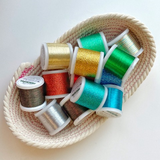Backing, Borders, & Batting—Oh My! Beginner Quilting Terms
Are you so overwhelmed by all the quilting terminology out there that your head is spinning? Not to worry! Sit n’ Sew Fabrics has put together the most essential quilting terms you need to get started. Once you’ve learned these basics, you’ll be able to talk like a quilter in no time. Bookmark this page for future reference if you get stuck.
Essential Quilting Terms
Appliqué: A piece of fabric, usually an image or decorative design, that’s sewn on top of another fabric piece.
Backing: The back layer of a quilt. A quilt is generally made of three pieces: the quilt top in front, the batting in the middle, and the backing at the back.
Basting: Long, loose stitches that hold the three quilt layers in place. These are removed once you’re done quilting.
Batting: The middle layer of a quilt between the quilt top and the backing. Generally made of cotton, wool, or polyester filling.
Bearding: Batting fibers that poke through the quilt top, usually as a result of cheap batting. Betweens: Thin, short needles used for hand sewing.
Bias: A line that runs diagonally between the crosswise or lengthwise grain line. This is more stretchy and less stable to cut along than the grain.
Binding: The strips of fabric sewn around the edge of the quilt that cover the raw edges.
Blocks: The basic units of a quilt—usually squares. A simple quilt might have 12 blocks sewn in a 3x4 grid.
Bobbins: The cylinders found in sewing machines that the thread winds around.
Borders: The strips of fabric that frame the quilt inside the binding.
Charm Pack: A quilting term referring to any small, eclectic pieces of fabric that are sewn together. Charm quilts are often made from scrap fabric.
Dresden Plate: A popular quilt appliqué pattern that consists of petal shapes surrounding a circle.
Easing: Maneuvering and distributing fabric so that it lies flat and even for sewing.
Fat Quarter: A half yard of fabric cut vertically in half so that it measures 18” x 22”.
Fussy Cut: Cutting out a specific image from printed fabric.
Half-Square Triangle: The triangle created when a square is cut in half.
Jelly Roll: A bundle of precut fabric strips, usually sold by quilting companies.
Layer Cake: A bundle of 10” x 10” fabric squares.
Log Cabin: A popular quilt pattern featuring long strips assembled around a center square.
Long Arm Quilting Machine: A very large sewing machine designed for quilting.
Nine-Patch: A 3 x 3 quilt block that is perfect for beginners.
Notches: A “V” shape marked on a curved seam that is used as an accuracy method for even sewing.
Panel Quilt: A quilt made from a pre-printed piece of fabric, usually depicting a scene or design. These do not need to be cut before quilting.
Patchwork: Also known as “piecework” or “piecing,” this is the process of sewing many small pieces of fabric together into a quilt top.
Presser Foot: In a sewing machine, the metal part around the needle that stabilizes the fabric and keeps it flat.
Pressing: Using an iron to flatten seams and blocks. This is done by holding the iron flat down on the fabric and not moving it back and forth so as to not stretch or warp the fabric.
Prewash: Washing your fabric first in order to prevent dye bleed and shrinkage.
Quilting: Yes, this counts as a quilting term. This is technically the process of sewing together the three parts of the quilt: the quilt top, batting, and backing.
Quilt Sandwich: Layering the three quilt parts together to align them before quilting.
Quilt Top: The top layer of a quilt sandwich, usually made of a single panel or a patchwork pattern.
Raw Edge: The unsewn edge of fabric, usually hidden after binding or left exposed as a decorative element.
Reverse Appliqué: Applying an appliqué by sewing it to the back of the background fabric and cutting away the background fabric to reveal the appliqué underneath.
Rotary Cutter: A tool used for cutting on a fabric mat, consisting of a sharp circular blade you can roll across the fabric.
Sampler Quilt: A quilt made of blocks with a simple pattern, a great bit of quilting terminology for beginners to take advantage of.
Sashing: The fabric that frames or borders the blocks, separating them from each other.
Seam Allowance: The distance between the edge of the fabric and the seam that’s stitched together. This is traditionally ¼ of an inch.
Stash: The quilting term referring to a quilter’s fabric collection.
Stippling: Sewing a pattern of curved lines over the quilt top, a technique which allows for the stitches to become a prominent part of the design.
Unit: Two or more sections of blocks that come together to create a quilt.
Walking Foot: A unique type of presser foot that attaches to a sewing machine that features grippers on the bottom, feeding your quilt through more evenly.
The More You Sew, The More You Know!
This is just a little sampler of all the quilting terminology out there. There are so many regional
techniques and slang out there that quilters never stop learning—and that’s a big part of the fun!
At Sit n’ Sew, we want to make quilting easy and accessible for everyone. Whether you’re a total beginner, someone with mobility issues, or an old pro, our precut quilt kits are the perfect craft. We’ve done the tricky cutting so you can focus on sewing!
Have questions? Contact us and we’ll be happy to help.
Recent Posts
-
5 Common Mistakes Embroiderers Make (Even us!)
As seasoned embroiderers, we've seen our fair share of mistakes - both by beginners and experienced …Apr 4th 2024 -
Mastering Metallic Thread: Tips for Stunning Embroidery
Metallic embroidery thread adds a touch of glamour and sophistication to your embroidery projects, b …Dec 29th 2023 -
Sustainable Stitching: Creative Ways to Reuse Embroidery Backing
Embroidery is a timeless craft that brings art to life, but it often generates leftover bits of embr …Dec 18th 2023




